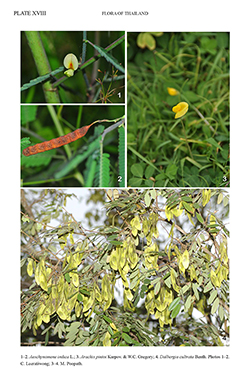e-Flora of Thailand
Volume 4 > Part 3 > Year 2018 > Page 280 > Leguminosae-Papilionoideae > Aeschynomene
3. Aeschynomene indica L.wfo-0000173414
Sp. Pl. 2: 713. 1753; Burm., Fl. Ind.: 169. 1768; Wight, Ic. Pl. Ind. Or.: 405. 1840–1843; Miq., Fl. Ind. Bat. 1(1): 274. 1855; Thwaites, Pl. Zeyl.: 85. 1859; Baker in Hook.f., Fl. Brit. India 2: 151. 1876 & Prain, J. Asiat. Soc. Bengal, Pt. 2, Nat. Hist. 66(2): 128. 1897; Trimen, Handb. Fl. Ceylon 2: 38. 1894; Forbes & Hemsley, J. Linn. Soc. Bot. 23: 170. 1886; Merr., Philipp. J. Sci. C5: 76. 1910; Gagnep. in Lecomte, Fl. Indo-Chine 2(5): 559. 1920; Ridl., Fl. Malay Penins. 1: 602. 1922; Craib, Fl. Siam. 1(3): 401. 1928; Rudd, Reinw. 5(1): 30. 1959; Ali, Fl. W. Pakistan, no. 100: 338. 1977; Rudd in Dassanayake & Fosberg, Revis. Handb. Fl. Ceylon 7: 163. 1991; Huang & Ohashi in Haung, Fl. Taiwan 3: 161, pl. 512. 1977 & ed. 2, 3: 192. 1993; Lock & Heald, Legumes Indo-Chine: 50. 1994; R.Sha & A.Delgado in Z.Y.Wu et al., Fl. China 10: 132. 2010. Plate XVIII: 1−2.
Accepted Name : This is currently accepted.
Synonyms & Citations :
Description : Annual herb or shrublet 1−2.5 m tall; stems erect or decumbent, glabrous to hispid. Stipules oblong-triangular, peltate-appendiculate, 10−15 by 1−1.5 mm, glabrous or somewhat hispid at the point of attachment, striate, caducous. Leaves paripinnate, alternate; petioles 4−5 mm long; rachis up to 1.5 mm long. Leaflets 60−80 pairs, alternate, elliptic-oblong, 2−10 by 1−2.5 mm, apex rounded, base oblique, margin entire, glabrous, with 1 primary vein, inconspicuous above, conspicuous beneath; rachis 0.7−4 cm long; petiolules ca 0.5 mm long. Inflorescences axillary or terminal, racemose, 1−4-flowered, ca 2.5 cm long, rachis rough, 1−4-flowered as on the petioles; peduncle 3−8 cm long; bracts thin, 5 by 1−2 mm, ovate-oblong apex acute, base cordate; bracteoles lanceolate-ovate, 2−4 by 1 mm, apex acute. Flowers 7−10 mm long. Calyx bilabiate, 4−6 mm long, glabrous. Corolla yellow, sometimes almost white, glabrous; standard broadly elliptic, ca 2 mm long, apex rounded, base clawed; wings obliquely obovate, 2 by 5−8 mm; keel asymmetrically ovate-oblong, 2.5−4 by 4−5 mm. Stamens 8−9 mm long, glabrous. Ovary flattened. Pods 5−6 cm long, straight, abaxial suture straight, 5−12 quadrate seed bearing segments; seed bearing segments 5−6 by 3−6 mm, glabrous to hispid. Seeds reniform, 3−4 by 2−3 mm, dark brown.
Thailand : NORTHERN: Chiang Mai (Fang, Phrao), Chiang Rai, Phayao (Kwan Phayao), Nan (Doi Phu Kha NP), Tak (Wang Chao), Phitsanulok (Pha Mui Daeng to Wat Hua Kao, Wang Thong); NORTH-EASTERN: Loei (Na Haeo); EASTERN: Si Sa Ket (Uthum Phon Phisai); CENTRAL: Ang Thong, Nakhon Pathom (Salaya), Krung Thep Maha Nakhon (Bangkok) (Bangkhen); SOUTH-EASTERN: Prachin Buri, Chachoengsao, Rayong (Klaeng), Chanthaburi (Pong Nam Ron); PENINSULAR: Chumphon, Songkhla (Chana).
Distribution : Africa, Tropical Asia (India – type), Japan, Australia.
Ecology : In sunny sites, wet places, along roadsides, paddy fields, swampy areas, from sea level to 1,500 m alt. Flowering and fruiting: July–November.
Vernacular : Sano hang kai lek (โสนหางไก่เล็ก)(Ang Thong); sano hin (โสนหิน)(Central).
CommonName : Indian joint-vetch.
Uses: Green manure.

